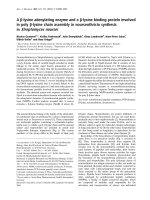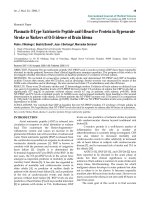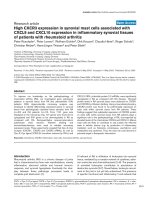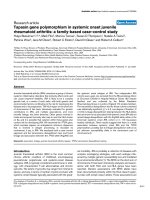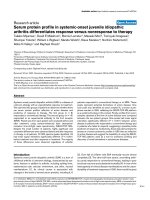Báo cáo y học: "Targeting B cells in systemic lupus erythematosus: not just déjà vu all over again" pdf
Bạn đang xem bản rút gọn của tài liệu. Xem và tải ngay bản đầy đủ của tài liệu tại đây (38.73 KB, 2 trang )
Page 1 of 2
(page number not for citation purposes)
Available online />Abstract
Epratuzumab (anti-CD22) is a humanized monoclonal antibody that
recognizes a pan-B-cell marker. It potentially downregulates B cell
activity through negative signaling, as well as depleting B cells
moderately. The uncontrolled series discussed by Dörner and
colleagues in this issue of Arthritis Research & Therapy suggests
that epratuzumab may be safe and efficacious for systemic lupus
erythematosus. A randomized controlled trial is currently active to
test this possibility.
The article by Dörner and colleagues in the current issue of
Arthritis Research & Therapy describes an open-label phase I
trial of the B cell-specific humanized monoclonal antibody
epratuzumab (anti-CD22) in 14 patients with moderately
active systemic lupus erythematosus (SLE) (one or more
British Isles Lupus Assessment Group (BILAG) Bs in all
patients except one) [1]. Clinical improvement was seen in all
patients by 7 to 10 weeks after initiation of the 6-week course
of four infusions. The infusions were generally well tolerated,
and overall no repeated safety signals were seen. Other than
a modest and inconsistent fall in B cell counts in peripheral
blood, no laboratory parameters were affected, including
autoantibodies and complement. These data are supportive
of the rationale for the currently active randomized controlled
trial of epratuzumab to establish efficacy in SLE.
Like the rituximab target (CD20), CD22 is a cell surface
protein uniquely expressed on normal B cells from the early
stages of development (pre-B) until differentiation into plasma
cells [2,3]. Also like rituximab, the initial experience with
epratuzumab was with B cell lymphomas, in which it has
shown some suggestion of efficacy in uncontrolled series [4].
Beyond these obvious parallels, however, the stories diverge.
The CD22 molecule can clearly deliver intracellular signals,
either constitutively or after interaction with its ligand, which
is an α2,6-sialic acid residue found in many glycoproteins,
including IgM and other cell surface proteins. The effect of
CD22 signaling is generally, but not entirely, negative or anti-
stimulatory, both in terms of Ca
2+
flux and protein tyrosine
phosphorylation. It modifies signaling through other cell
surface molecules, including the B cell receptor (BCR),
CD19/21, and CD45. Mice in which the CD22 gene has
been disrupted show hyperresponsiveness of B cells to BCR
crosslinking, yet paradoxically a deficit in response to T cell-
independent antigens. In conjunction with other genetic risks
for autoimmunity, the lack of CD22 heightens the propensity
to develop SLE [5,6]. In addition, mouse strains that
spontaneously develop SLE on a multigenic basis
preferentially express CD22 alleles that have functional
deficiencies [7]. Finally, some human evidence also links
CD22 polymorphisms to SLE [8]. Thus, the CD22 molecule
is more than mainly just a useful target on B cells, as with
CD20, but also has several functions that may be relevant to
the pathogenesis of autoimmunity.
The potential efficacy of targeting CD22 in SLE might
therefore not be mediated by the partial depletion of B cells
observed. Epratuzumab might modify the function of B cells
without killing them. It does not block interactions of CD22
with its ligand, as do some anti-CD22 monoclonal antibodies,
but it does initiate signaling through the CD22 molecule [9].
Given the heterogeneity of CD22-mediated responses in
experimental systems, the possible consequences of such
signaling in a given patient cannot readily be predicted. In
fact, the published experience with epratuzumab in
lymphoma, in which cell killing is presumably necessary for
efficacy, suggests that this agent has only very modest
capabilities when used alone and unaltered. Because the
CD22 molecule is rapidly internalized after antibody binding
(unlike CD20), it has been predicted that anti-CD22 would
Commentary
Targeting B cells in systemic lupus erythematosus:
not just
déjà vu
all over again
Robert Eisenberg
Division of Rheumatology, Department of Medicine, University of Pennsylvania, School of Medicine, 756 BRBII/III, 421 Curie Boulevard, Philadelphia,
PA 19104-6160, USA
Corresponding author:
Published: 15 May 2006 Arthritis Research & Therapy 2006, 8:108 (doi:10.1186/ar1967)
This article is online at />© 2006 BioMed Central Ltd
See related research article by Dörner et al., />BCR = B cell receptor; BILAG = British Isles Lupus Assessment Group; SLE = systemic lupus erythematosus.
Page 2 of 2
(page number not for citation purposes)
Arthritis Research & Therapy Vol 8 No 3 Eisenberg
be an excellent vehicle for the delivery of toxic moieties to B
cells. This seems to be true, because epratuzumab
conjugated with toxin or radiolabel leads to substantially
higher response rates in B cell lymphomas than the agent
alone [10]. Such approaches also create more clinical
adverse reactions and would probably not be acceptable for
use in SLE. Another curious finding in the lymphoma
experience is that combining epratuzumab with rituximab,
although not increasing the overall clinical response rate
above what is seen with rituximab alone, may lead to a
substantially higher number of complete responders or
persistent responders [11].
The nearly complete lack of changes in biological markers in
patients treated with epratuzumab on the one hand reflects
the benignity of the agent. It can be infused rapidly over less
than 1 hour without serious infusion reactions, and so far no
major toxicities have emerged. One trivial possibility is that
the binding of CD22 changes little in the organism, and thus
the current randomized controlled trial may fail to find
evidence for therapeutic efficacy. Assuming, however, that
epratuzumab will be shown to improve SLE clinically, then the
lack of biological markers of its effects may in fact be a
drawback to its rational use. Because even the fall in B cells
in peripheral blood is quite modest and inconsistent (Figure 5
in [1]), there is at present no obvious way to follow patients
for physiological effects of the treatment or for the need for
retreatment, which will probably be required as is true of
rituximab [1].
It is unfortunate that there is only limited preclinical
information available on the signaling mediated by
epratuzumab binding to CD22 on various subsets of B cells
[9]. Several monoclonal antibodies against mouse CD22
have been available for several decades, yet no studies of
using these reagents in mouse SLE models have appeared.
In our own unpublished experience, we have found that at
least two of the anti-mouse CD22 monoclonal antibodies do
not deplete B cells in vivo.
The failure to find evidence for an immune response by the
treated patients to the administered epratuzumab (human
anti-humanized antibody or HAHA) is very reassuring, and
contrasts with the rituximab experience, in which in SLE (as
opposed to rheumatoid arthritis or lymphoma) a substantial
fraction of patients responded to the agent with human anti-
chimeric antibodies or HACA [12]. Presumably, this result
depends partly on the lesser degree of ‘foreignness’ of the
humanized reagent versus a chimeric one.
So what might be the future for epratuzumab in SLE or
perhaps other autoimmune diseases? In part, the rituximab
experience will determine the way, because development of
that drug is much further advanced, with 9 years of approved
use in lymphoma and recent approval in rheumatoid arthritis.
However, it seems unlikely that epratuzumab will be just a
weaker cousin of rituximab. Its mechanisms of action are
probably quite distinct, and therefore its spectrum of clinical
usefulness should not be completely overlapping. Perhaps it
will synergize with rituximab or other biologicals, as is
suggested in the lymphoma experience.
Competing interests
RE has received support from Genentech for investigator and
industry sponsored clinical trials, basic laboratory work and
consultations regarding the development of rituximab for use
in autoimmune diseases. RE has been involved with the
development of anti-CD20 for SLE
References
1. Dörner T, Kaufmann J, Wegener WA, Teoh N, Goldenberg DM,
Burmester GR: Initial clinical trial of epratuzumab (humanized
anti-CD22 antibody) for immunotherapy of systemic lupus
erythematosus. Arthritis Res Ther 2006, 8:R74.
2. Tedder TF, Poe JC, Haas KM: CD22: a multifunctional receptor
that regulates B lymphocyte survival and signal transduction.
Adv Immunol 2005, 88:1-50.
3. Eisenberg R, Looney RJ: The therapeutic potential of anti-CD20
‘what do B-cells do?’. Clin Immunol 2005, 117:207-213.
4. Leonard JP, Coleman M, Ketas JC, Chadburn A, Ely S, Furman
RR, Wegener WA, Hansen HJ, Ziccardi H, Eschenberg M, et al.:
Phase I/II trial of epratuzumab (humanized anti-CD22 anti-
body) in indolent non-Hodgkin’s lymphoma. J Clin Oncol
2003, 21:3051-3059.
5. Otipoby KL, Andersson KB, Draves KE, Klaus SJ, Farr AG, Kerner
JD, Perlmutter RM, Law CL, Clark EA: CD22 regulates thymus-
independent responses and the lifespan of B cells. Nature
1996, 384:634-637.
6. O’Keefe TL, Williams GT, Batista FD, Neuberger MS: Deficiency
in CD22, a B cell-specific inhibitory receptor, is sufficient to
predispose to development of high affinity autoantibodies. J
Exp Med 1999, 189:1307-1313.
7. Mary C, Laporte C, Parzy D, Santiago ML, Stefani F, Lajaunias F,
Parkhouse RM, O’Keefe TL, Neuberger MS, Izui S, et al.: Dysreg-
ulated expression of the Cd22 gene as a result of a short
interspersed nucleotide element insertion in Cd22a lupus-
prone mice. J Immunol 2000, 165:2987-2996.
8. Hatta Y, Tsuchiya N, Matsushita M, Shiota M, Hagiwara K, Toku-
naga K: Identification of the gene variations in human CD22.
Immunogenetics 1999, 49:280-286.
9. Carnahan J, Wang P, Kendall R, Chen C, Hu S, Boone T, Juan T,
Talvenheimo J, Montestruque S, Sun J, et al.: Epratuzumab, a
humanized monoclonal antibody targeting CD22: characteri-
zation of in vitro properties. Clin Cancer Res 2003, 9:3982S-
3990S.
10. Postema EJ, Raemaekers JM, Oyen WJ, Boerman OC, Mandigers
CM, Goldenberg DM, van Dongen GA, Corstens FH: Final
results of a phase I radioimmunotherapy trial using
186
Re-
epratuzumab for the treatment of patients with non-Hodgkin’s
lymphoma. Clin Cancer Res 2003, 9:3995S-4002S.
11. Leonard JP, Coleman M, Ketas J, Ashe M, Fiore JM, Furman RR,
Niesvizky R, Shore T, Chadburn A, Horne H, et al.: Combination
antibody therapy with epratuzumab and rituximab in relapsed
or refractory non-Hodgkin’s lymphoma. J Clin Oncol 2005, 23:
5044-5051.
12. Looney RJ, Anolik JH, Campbell D, Felgar RE, Young F, Arend LJ,
Sloand JA, Rosenblatt J, Sanz I: B cell depletion as a novel
treatment for systemic lupus erythematosus: a phase I/II
dose-escalation trial of rituximab. Arthritis Rheum 2004, 50:
2580-2589.


